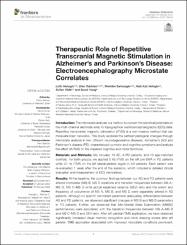| dc.contributor.author | Hanoğlu, Lütfü | |
| dc.contributor.author | Toplutaş, Eren | |
| dc.contributor.author | Sarıcaoğlu, Mevhibe | |
| dc.contributor.author | Velioğlu, Halil Aziz | |
| dc.contributor.author | Yıldız, Sultan | |
| dc.contributor.author | Yuluğ, Burak | |
| dc.date.accessioned | 2022-09-12T10:32:12Z | |
| dc.date.available | 2022-09-12T10:32:12Z | |
| dc.date.issued | 2022 | en_US |
| dc.identifier.uri | https://hdl.handle.net/20.500.12868/1563 | |
| dc.identifier.uri | https://www.frontiersin.org/journals/neuroscience/articles/10.3389/fnins.2022.798558/full | |
| dc.description.abstract | IntroductionThe microstate analysis is a method to convert the electrical potentials on the multi-channel electrode array to topographical electroencephalography (EEG) data. Repetitive transcranial magnetic stimulation (rTMS) is a non-invasive method that can modulate brain networks. This study explores the pathophysiological changes through microstate analysis in two different neurodegenerative diseases, Alzheimer's (AD) and Parkinson's disease (PD), characterized by motor and cognitive symptoms and analysis the effect of rTMS on the impaired cognitive and motor functions. Materials and MethodsWe included 18 AD, 8 PD patients, and 13 age-matched controls. For both groups, we applied 5 Hz rTMS on the left pre-SMA in PD patients while 20 Hz rTMS on the left lateral parietal region in AD patients. Each patient was re-evaluated 1 week after the end of the sessions, which included a detailed clinical evaluation and measurement of EEG microstates. ResultsAt the baseline, the common findings between our AD and PD patients were altered microstate (MS) B, MS D durations and transition frequencies between MS A-MS B, MS C-MS D while global explained variance (GEV) ratio and the extent and frequency of occurrence of MS A, MS B, and MS D were separately altered in AD patients. Although no specific microstate parameter adequately differentiated between AD and PD patients, we observed significant changes in MS B and MS D parameters in PD patients. Further, we observed that Mini-Mental State Examination (MMSE) performances were associated with the transition frequencies between MS A-MS B and MS C-MS D and GEV ratio. After left parietal rTMS application, we have observed significantly increased visual memory recognition and clock drawing scores after left parietal rTMS application associated with improved microstate conditions prominent, especially in the mean duration of MS C in AD patients. Also, pre-SMA rTMS resulted in significant improvement in motor scores and frequency of transitions from MS D to MS C in PD patients. ConclusionThis study shows that PD and AD can cause different and similar microstate changes that can be modulated through rTMS, suggesting the role of MS parameters and rTMS as a possible combination in monitoring the treatment effect in neurodegenerative diseases. | en_US |
| dc.language.iso | eng | en_US |
| dc.relation.isversionof | https://doi.org/10.3389/fnins.2022.798558 | en_US |
| dc.rights | info:eu-repo/semantics/openAccess | en_US |
| dc.subject | Alzheimer's disease | en_US |
| dc.subject | Parkinson's disease | en_US |
| dc.subject | EEG | en_US |
| dc.subject | rTMS | en_US |
| dc.subject | Microstate analysis | en_US |
| dc.title | Therapeutic role of repetitive transcranial magnetic stimulation in alzheimer's and parkinson's disease: Electroencephalography microstate correlates | en_US |
| dc.type | article | en_US |
| dc.contributor.department | ALKÜ, Fakülteler, Tıp Fakültesi, Dahili Tıp Bilimleri Bölümü | en_US |
| dc.identifier.volume | 16 | en_US |
| dc.identifier.startpage | 1 | en_US |
| dc.identifier.endpage | 12 | en_US |
| dc.relation.journal | Frontiers in Neuroscience | en_US |
| dc.relation.publicationcategory | Makale - Uluslararası Hakemli Dergi - Kurum Öğretim Elemanı | en_US |


















